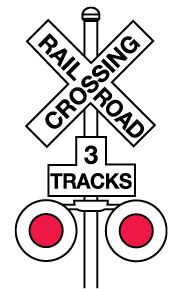Railroad Crossing Safety
There are over 5,000 miles of railroad tracks and 6,800 railroad crossings in North Carolina. With rail traffic increasing throughout North Carolina, it is more important than ever to practice safety at railroad crossings. Trains cannot stop quickly, but your vehicle can. Most trains that are traveling at 55 mph takes more than a mile to come to a complete stop. For this reason, it’s very important to know and follow the rules of the road when crossing railroads. Trains have the right-of-way over all highway traffic including police, fire and ambulance emergency vehicles.
Signs to look for:
A yellow and black “RR” sign indicates that you are approaching a railroad crossing. As you approach the tracks, look both ways and listen because you may have to stop. Trains can approach a crossing at any time from any direction. The train are always given the right of way. If there is a stop sign, you must come to a full stop before safely crossing.
A railroad crossing sign indicates you are approaching a railroad crossing and you must:


- Approach with caution.
- Prepare to stop, and be alert for a train.
- Proceed with caution after a train has passed.
- Never stop on train tracks for any reason.
Many crossings have flashing red lights or flashing red lights with gates. If the warning signal activates, you must stop before the gates lower across your side of the road. It is unlawful and extremely dangerous to move through a railroad crossing when the gates are lowered. You will not be able to cross the tracks before the train arrives; trains cannot turn and will not be able to stop.
Railroad related emergencies: what you need to know.
- All highway-railroad crossings in North Carolina are required to have an Emergency Notification System (ENS) sign posted in each traffic direction. The ENS sign, known as the “Blue Sign,” contains the railroad crossing identification number, name of the railroad company and an emergency telephone number to report emergencies, hazardous conditions or issues with railroad crossing’s lights or gates directly to the railroad company. Familiarize yourself with the “Blue Sign“ locations at railroad crossings during your travels.

At every railroad crossing, there is a Railroad Emergency Notification System (ENS) sign, also known as the Blue Sign.
- If your vehicle stalls on or near the tracks GET OUT IMMEDIATELY. Most trains, which may weigh several thousand tons, traveling at 55 mph may take more than a mile to stop. By the time the engineer on the train sees you, it is too late to stop the train.
- Move away from your vehicle and the tracks. Walk quickly along the roadway to a safe location away from the railroad tracks.
- When you are safely away from the tracks, locate the Blue Sign located at or near the railroad crossing and report the emergency.
Knowing how to use the Blue Sign to directly contact the railroad company is the quickest method to stop a train in the event of a railroad-related emergency.
Source: Content and images provided by the North Carolina Division of Motor Vehicles.
Stopping distance for a train
Most trains that travel at 55 mph take more than a mile to stop. . That is why it’s so important to know the rules of the road at train crossings. You never want to be stuck on the track when a train is coming.